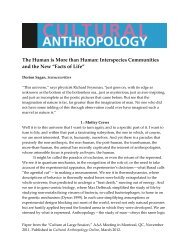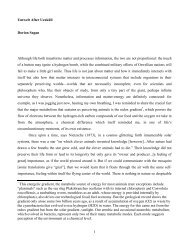PESTICIDES IN COCA-COLA AND PEPSI - Cultural Anthropology
PESTICIDES IN COCA-COLA AND PEPSI - Cultural Anthropology
PESTICIDES IN COCA-COLA AND PEPSI - Cultural Anthropology
You also want an ePaper? Increase the reach of your titles
YUMPU automatically turns print PDFs into web optimized ePapers that Google loves.
CULTURAL ANTHROPOLOGY 22:4<br />
668<br />
and attitudes on a host of broader issues related to the role and responsibilities<br />
of MNCs and private enterprise in defining and catering to the public good. The<br />
remainder of this article is devoted to delineating some of these themes that recur<br />
in the media commentary and to exploring the potential and limits of consumerism<br />
as a transformative social force.<br />
CORPORATE MANAGEMENT OF BR<strong>AND</strong> IMAGE: A VIABLE BASIS<br />
FOR A NEW SOCIAL CONTRACT?<br />
One of the constant refrains in the media commentary, even when unsympathetic<br />
to MNCs, pertains to the presumed centrality of brand image in their<br />
marketing calculus. The impetus for corporate responsibility, it is reasoned, will<br />
come not necessarily from the development of a social conscience but from a<br />
self-interested concern for preserving and enhancing brand equity in a fiercely<br />
competitive marketplace. Numerous narratives involve favorable juxtaposition of<br />
MNCs with the domestic companies, and of course, the state, which are described<br />
as largely unencumbered by such concerns. The MNCs, however, are supposed to<br />
have too much to lose by allowing their image to be tarnished. A commentator in<br />
Financial Times made clear the hierarchy of consumer expectations:<br />
It may not be much comfort to the managers of PepsiCo and Coca-Cola . . . but<br />
the soft drink campaign is a back-handed complement to big international<br />
brands. The CSE is relying on the fact that Indians expect little from the<br />
government but want good service from private companies and demand the<br />
highest standards of all from foreign multinationals. [2003]<br />
The potential of brands and brand images to provide a platform in which<br />
consumer preferences and corporate goals can be brought together in a dynamic,<br />
mutually beneficial, dialogue, however, appears premised on specific assumptions<br />
about branding. Despite the attempts of brand managers to evolve generic formulae,<br />
the use of which will result in a linear and unidirectional transfer of content—from<br />
the corporation to the consumer—the communicative process remains open-ended<br />
and prone to slippages. In a situation rife with indeterminacy, trust is often invoked<br />
as a substitute for the elusive profile of consumer expectations. The vice president<br />
of The Coca-Cola Company described its efforts to win back consumer trust, in<br />
the aftermath of the controversy, as work in progress: “We are still conceptualizing<br />
our consumer-connect exercise—this could include television, print, and online<br />
advertising, on-ground activity and meeting up with retailers” (Bhushan 2003).






